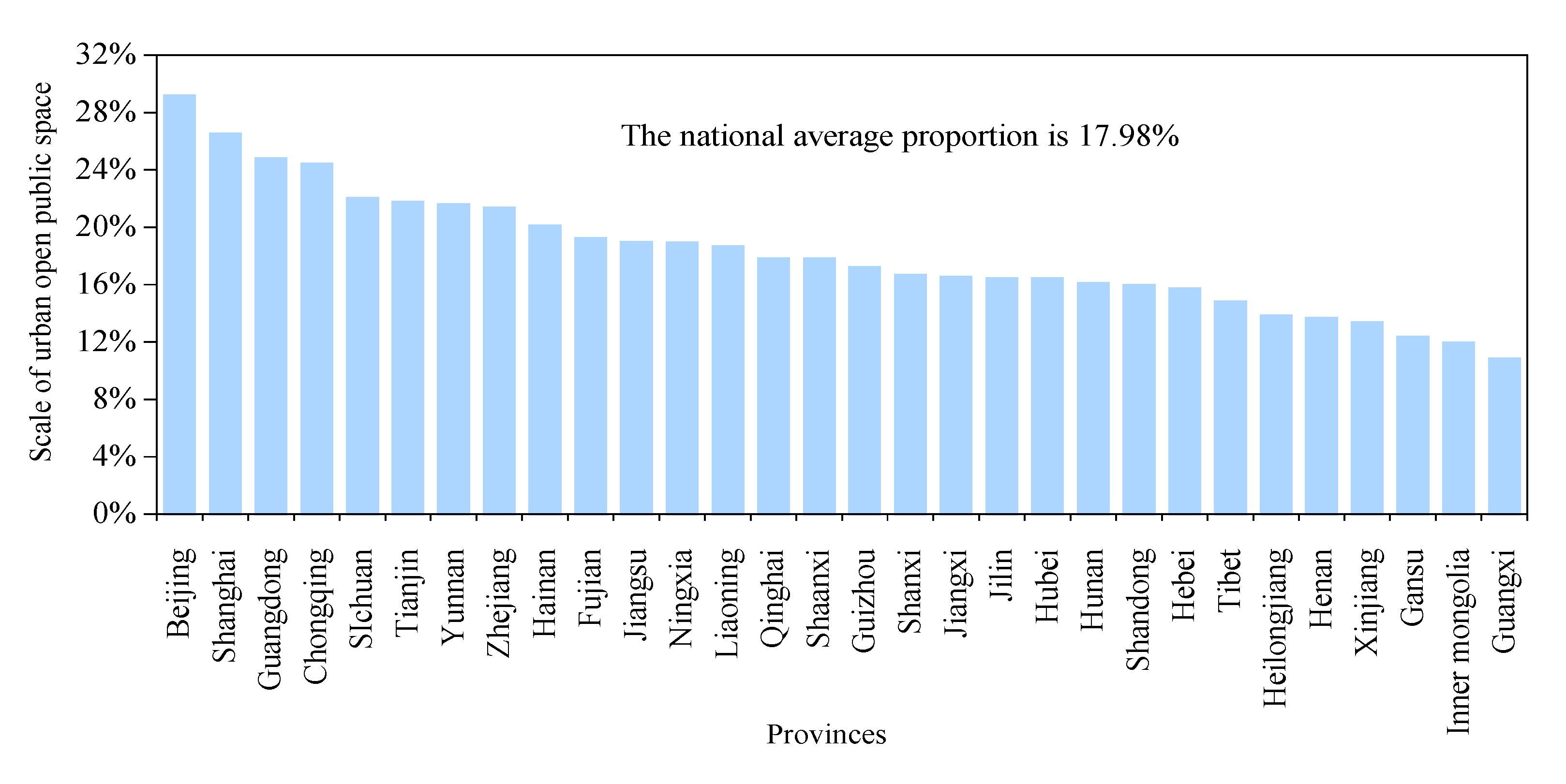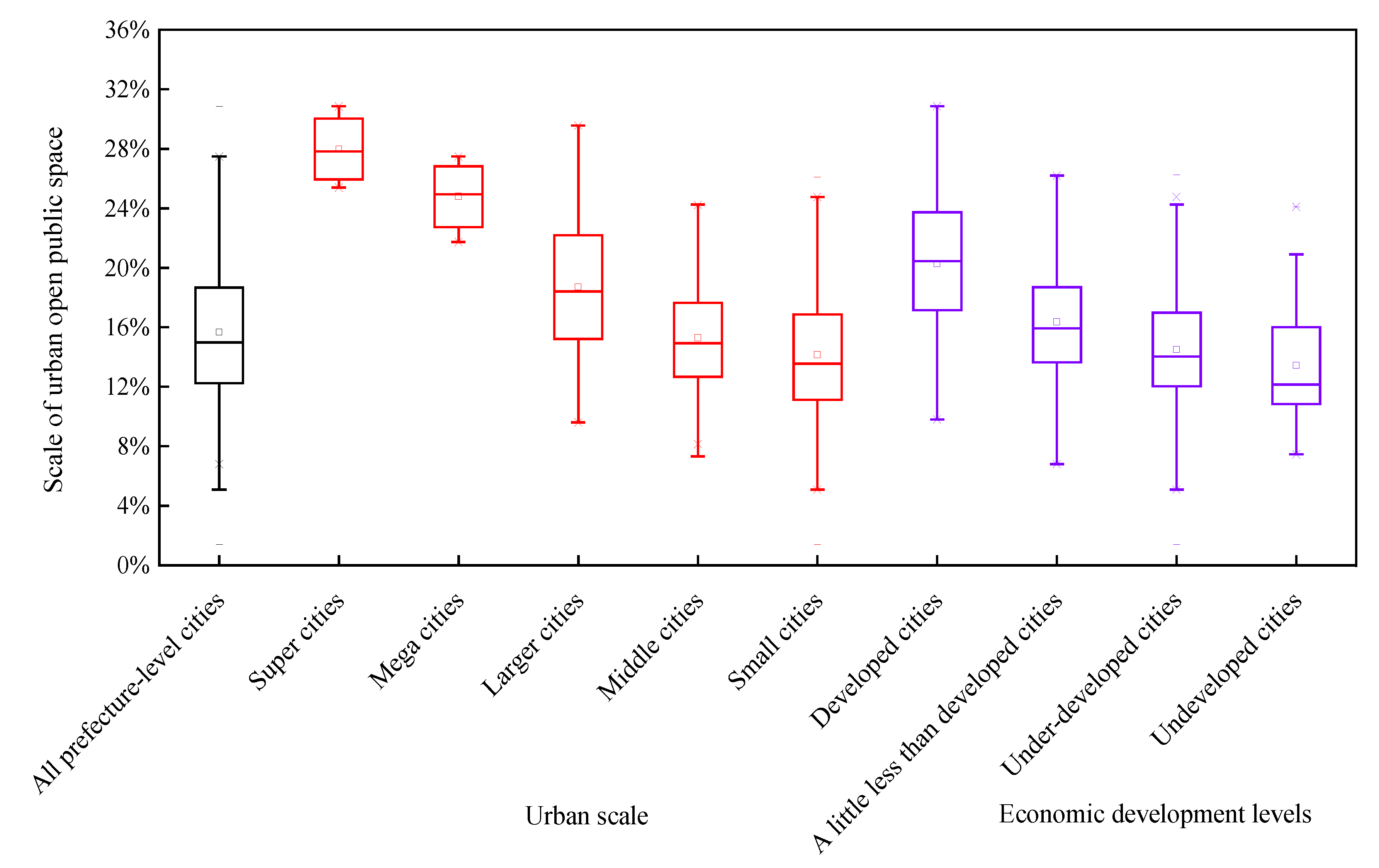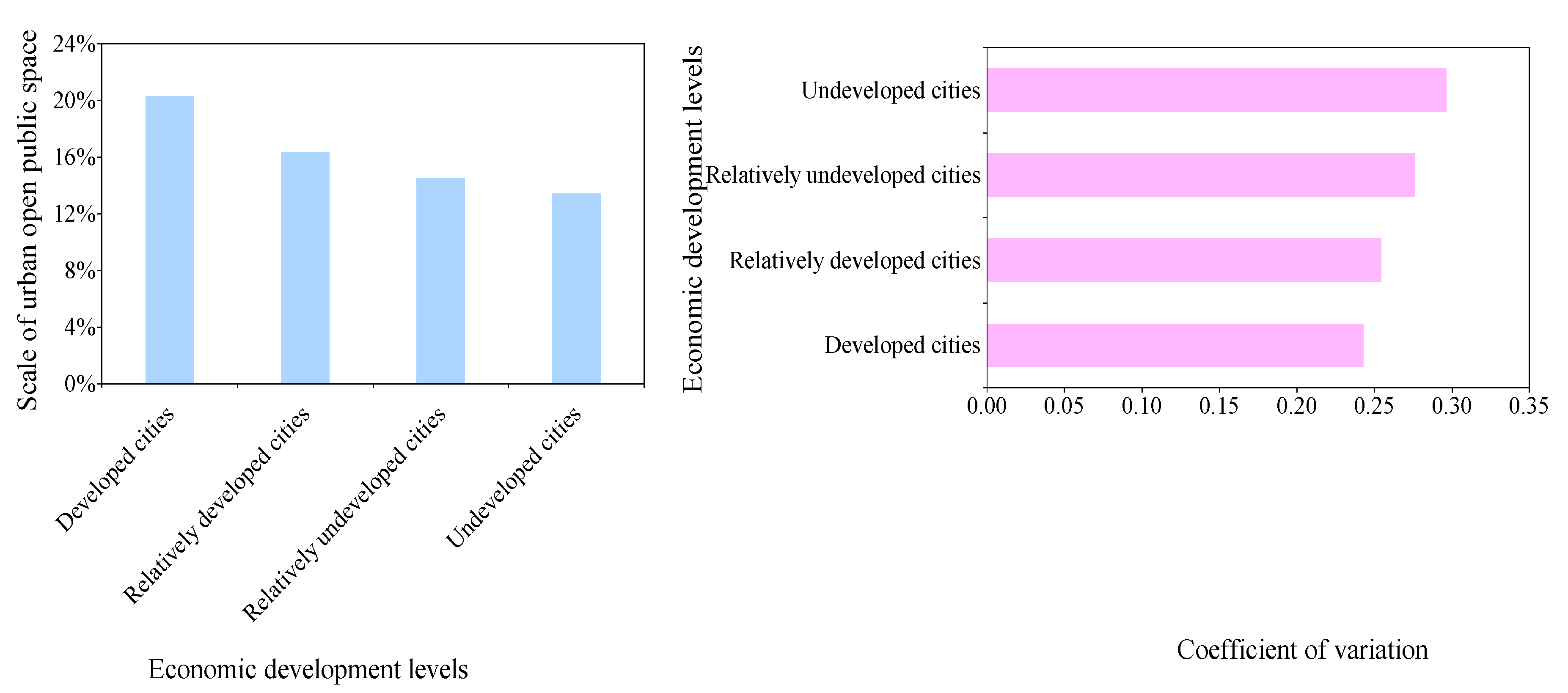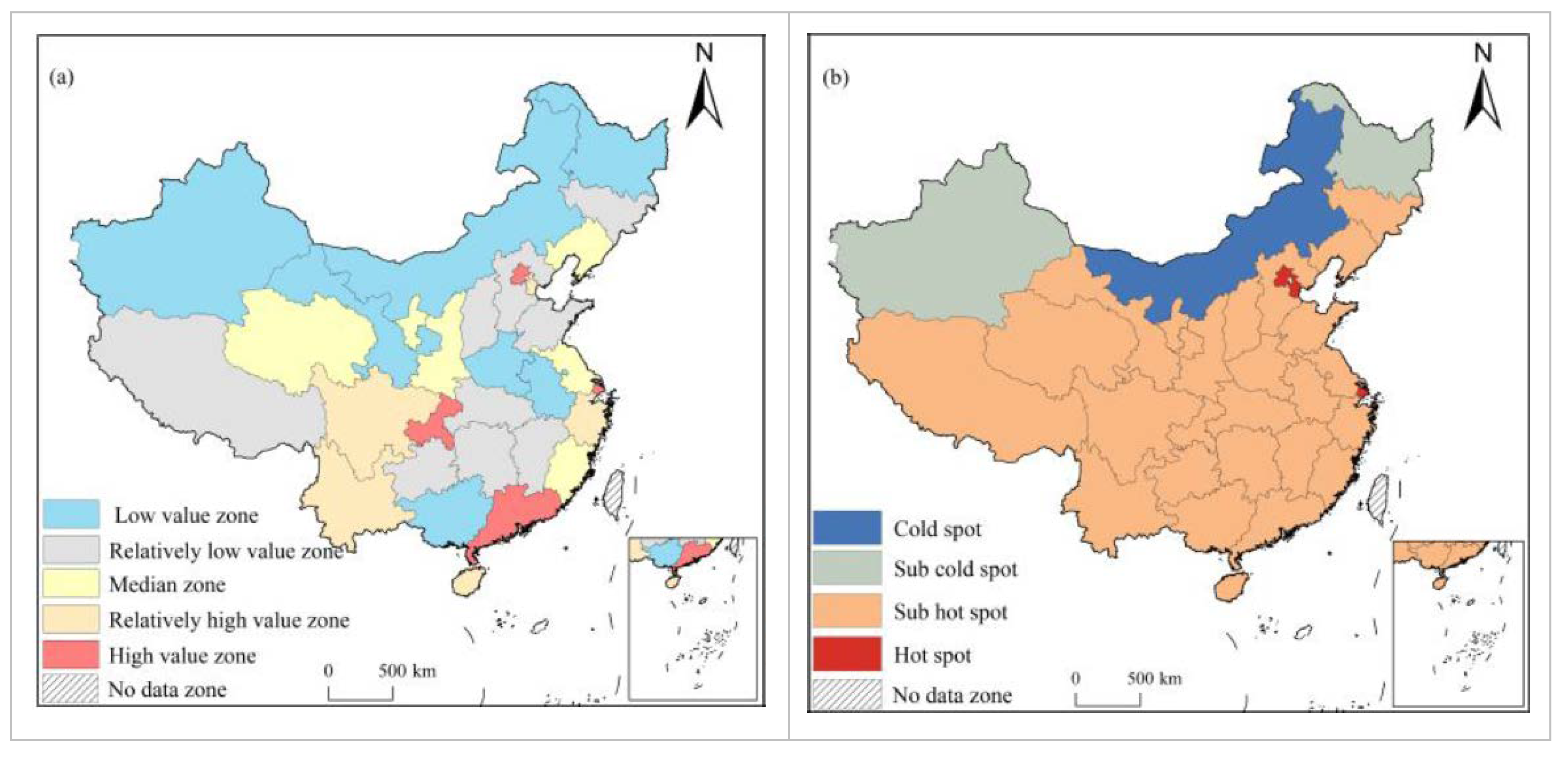Regional Differences and Influential Factors of Open Public Space in Chinese Cities Based on Big Earth Data
Abstract
1. Introduction
2. Materials and Methods
2.1. Data Source
2.2. Methods
2.2.1. Measurement of Urban Open Public Space
2.2.2. Regional Differences Measure of Urban Open Public Space
2.2.3. Spatial Pattern Measurement of Urban Open Public Space
2.2.4. Analysis of the Factors Affecting the Distribution of Urban Open Public Space
3. Results
3.1. Differences in the Scale of Open Public Space in Chinese Cities
3.1.1. Open Public Space Differences at Provincial Level
3.1.2. Open Public Space Differences in Prefecture-Level Cities
3.2. Spatial Distribution of Urban Open Public Space Scale in Chinese Cities
3.2.1. Spatial Distribution of Open Public Space Scale at Provincial Level
3.2.2. Spatial Distribution of Open Public Space Scale in a Prefecture-Level City
3.3. Factors Affecting the Scale of Urban Open Public Space
4. Discussion
4.1. Spatial Heterogeneity of Urban Open Public Space
4.2. The Residents’ Living Standards and the Scale of Urban Open Public Space
4.3. The Economic Development Level and the Scale of Urban Open Public Space
4.4. The Population Size and the Scale of Urban Open Public Space
5. Conclusions
Author Contributions
Funding
Acknowledgments
Conflicts of Interest
References
- Dong, Y.; Dong, W. The Construction of Ecological Functions of Urban Open Space. Appl. Mech. Mater. 2011, 99, 606–610. [Google Scholar] [CrossRef]
- Wei, F.; Li, W.M.; HuangPu, J.Q. A study on urban open space planning standards. City Plan. Rev. 2016, 40, 74–80. [Google Scholar]
- Debnath, A.K.; Chin, H.C.; Haque, M.M.; Yuen, B. A methodological framework for benchmarking smart transport cities. Cities 2014, 37, 47–56. [Google Scholar] [CrossRef]
- United Nations. World Urbanization Prospects: The 2014 Revision; United Nations Department of Economic and Social Affairs Population Division: New York, NY, USA, 2014. [Google Scholar]
- United Nations. World Cities Report 2016; UN-HABITAT: Nairobi, Kenya, 2016. [Google Scholar]
- Pan, J.H.; Wei, H.H. Urban Blue Book: China’s Urban Development Report NO.8; Social Sciences Academic Press: Beijing, China, 2015. [Google Scholar]
- Fang, C.L.; Zhou, C.H.; Gu, C.L. Theoretical analysis of interactive coupled effects between urbanization and eco-environment in mega-urban agglomerations. Acta Geogr. Sin. 2016, 71, 531–550. [Google Scholar] [CrossRef]
- United Nations. Transforming Our World: The 2030 Agenda for Sustainable Development. 2015. Available online: https://sustainabledevelopment.un.org/post2015/transformingourworld/publication (accessed on 25 September 2015).
- Mehaffy, M.W.; Elmlund, P.; Farrell, K. Implementing the New Urban Agenda: The central role of public space. Urban Des. Int. 2019, 24, 4–6. [Google Scholar] [CrossRef]
- Wüstemann, H.; Kalisch, D.; Kolbe, J. Access to urban green space and environmental inequalities in Germany. Landsc. Urban Plan. 2017, 164, 124–131. [Google Scholar] [CrossRef]
- Fan, P.; Xu, L.; Yue, W.; Chen, J.Q. Accessibility of public urban green space in an urban periphery: The case of Shanghai. Landsc. Urban Plan. 2016, 165, 177–192. [Google Scholar]
- Kabisch, N.; Strohbach, M.; Haase, D.; Kronenberg, J. Urban green space availability in European cities. Ecol. Indic. 2016, 70, 586–596. [Google Scholar] [CrossRef]
- Bertram, C.; Rehdanz, K. The role of urban green space for human well-being. Ecol. Econ. 2015, 120, 139–152. [Google Scholar] [CrossRef]
- Kilnarová, P.; Wittmann, M. Open Space between Residential Buildings as a Factor of Sustainable Development—Case Studies in Brno (Czech Republic) and Vienna (Austria). In IOP Conference Series: Earth and Environmental Science; IOP Publishing: Bristol, UK, 2017; Volume 95, pp. 1–13. [Google Scholar]
- Aletta, F.; Lepore, F.; Kostara-Konstantinou, E.; Kang, J.; Astolfi, A. An experimental study on the influence of soundscapes on people’s behaviour in an open public space. Appl. Sci. 2016, 6, 276. [Google Scholar] [CrossRef]
- Bahriny, F.; Bell, S. Patterns of Urban Park Use and Their Relationship to Factors of Quality: A Case Study of Tehran, Iran. Sustainability 2020, 12, 1560. [Google Scholar] [CrossRef]
- Jiang, H.Y.; Xiao, R.B.; Liang, H.Y.; Yao, J.C.; Li, Z.S. Methods and practices of collaborative planning of urban-rural open space: Acase study of nanhal district Foshan city. City Plan. Rev. 2018, 42, 44–50. [Google Scholar]
- Yang, G.Q. Diverse metropolitan open spaces ensure urban livability: Analysis of international design work camp for Frankurt Rhine-Main metropolitan region in Germany. Urban Plan. Forum 2014, 2, 105–111. [Google Scholar]
- Chen, K.L.; Gong, J.Z.; Liu, Y.S.; Chen, X.Y. The Spatial-temporal differentiation of green space and its fragmentation during the past thirty-five year in Guangzhou. J. Nat. Resour. 2016, 31, 1100–1113. [Google Scholar]
- Li, Z.M.; Fan, R.T. Visuaization analysis of foreign open space research evolution and frontiers. Urban Plan. Int. 2017, 36, 34–53. [Google Scholar] [CrossRef]
- Jin, Y.; Fan, W.; Zhou, X. Landscape typology research on the combination of linear open space and sustainable modes of transportation in the center of the street. Urban Rural. Plan. 2018, 1, 69–77. [Google Scholar]
- Song, P.; Kim, G.; Mayer, A.; He, R.; Tian, G. Assessing the Ecosystem Services of Various Types of Urban Green Spaces Based on i-Tree Eco. Sustainability 2020, 12, 1630. [Google Scholar] [CrossRef]
- Juanle, W.; Cheng, K.; Bian, L.; Han, X.; Wang, M. Integration Framework and Key Technology of Big Earth Data for SDGs and Beautiful China Evaluation. Remote. Sens. Technol. Appl. 2018, 33, 775–783. [Google Scholar]
- Andries, A.; Morse, S.; Murphy, R.J.; Lynch, J.; Woolliams, E.R. Seeing Sustainability from Space: Using Earth Observation Data to Populate the UN Sustainable Development Goal Indicators. Sustainability 2019, 11, 5062. [Google Scholar] [CrossRef]
- UN-HABITAT. SDG Indicators Metadata Repository. 2018. Available online: https://unstats.un.org/sdgs/metadata/ (accessed on 4 March 2016).
- Zhao, X.Y.; Wang, W.J.; Wan, W.Y. Regional inequalities of residents’ health level in China: 2003–2013. Acta Geogr. Sin. 2017, 72, 685–698. [Google Scholar]
- Zhao, X.Y.; Ma, Y.Y.; Chen, H.H.; Gao, Z.Y.; Xu, B. Spatio-Temporal Distribution of Rural Multidimensional Poverty and Influencing Factors in the Inland River Basin of Arid Areas—A Case Study of Shiyang River Basin. Econ. Geogr. 2018, 38, 140–147. [Google Scholar]
- Wang, J.F.; Xu, C.D. Geodetector: Principle and prospective. Acta Geogr. Sin. 2017, 72, 116–134. [Google Scholar]
- Wang, J.F.; Zhang, T.L.; Fu, B.J. A measure of spatial stratified heterogeneity. Ecol. Indic. 2017, 67, 250–256. [Google Scholar] [CrossRef]
- Liu, Z.Q.; Zhou, Y.Y.; Wang, J.D. Spatial Pattern Evolution of city scale Green Rate of Built District in China. J. Northwest For. Univ. 2019, 9, 28–36. [Google Scholar]
- Wu, B.Y.; Zhong, Q.L.; Cheng, D.L.; Sun, X.M.; Zhang, P.S. Research on spatial distribution characteristics and its influencing factors of the city green space in China. J. Shenyang Univ. Soc. Sci. 2012, 14, 13–16. [Google Scholar]
- Ye, J.H. Study on the regional differences and influencing factors of urban greening construction level in China. Product. Res. 2013, 6, 94–96. [Google Scholar]
- Choumert, J. An empirical investigation of public choices for green spaces. Land Use Policy 2010, 27, 1123–1131. [Google Scholar] [CrossRef]
- Jeffrey, K. Public demand for preserving local open space. Soc. Nat. Resour. 2006, 19, 645–659. [Google Scholar]
- Kahn, M.E.; Matsusaka, J.G. Demand for environmental goods: Evidence from voting patterns on California initiatives. J. Law Econ. 1997, 40, 137–174. [Google Scholar] [CrossRef]
- Yue, B.J.; Lin, A.W.; Sun, C. The analysis of low-income people’s park green space accessibility based on 2SFCA in Wuhan. Mod. Urban Res. 2017, 8, 99–107. [Google Scholar]
- Ambrey, C.; Fleming, C. Public greenspace and life satisfaction in urban Australia. Urban Stud. 2014, 51, 1290–1321. [Google Scholar] [CrossRef]
- Xu, H.; Liu, Z.Q. China’surban built up area green space ratio from 1996-2013. Planners 2016, 32, 126–132. [Google Scholar]
- Liu, L.Y.; Liu, Z.Q.; Wang, J.D.; Hong, G.W. Spatial distribution patterns and impact mechanism of green space rate in built areas along 106 nation highway. J. Chin. Urban For. 2019, 4, 1–6. [Google Scholar]
- Chen, W.Y.; Wang, D.T. Economic development and natural amenity: An econometric analysis of urban green spaces in China. Urban For. Urban Green. 2013, 12, 435–442. [Google Scholar] [CrossRef]
- Liu, Z.Q.; Wang, J.D. Empirical Analysis on Regional Differences of Urban Green Space Construction Level in China Based on Theil indices. Chin. Landsc. Archit. 2015, 3, 81–85. [Google Scholar]








| Road Level | High Way | National Road | Provincial Road | County Road | Township Road | City Street | Pedestrian Path |
|---|---|---|---|---|---|---|---|
| Width (m) | 50 | 40 | 30 | 30 | 25 | 15 | 10 |
| Explanatory Variables | Description (Unit) | Mean | Standard Deviation |
|---|---|---|---|
| Economic development level | Per capita GDP (Yuan) | 49,686.45 | 29,916.65 |
| Population density | Total population/land area (people/km2) | 3779.69 | 2688.05 |
| Residents’ living standards | Per capita disposable income (Yuan) | 27,119.71 | 6528.48 |
| Urbanization rate | Proportion of urban population and Resident population (%) | 51.42 | 16.42 |
| Population size | Resident population (10,000 people) | 400.50 | 332.81 |
| Detection Index | q Value (Detection Index) | p Value (Significant Level) |
|---|---|---|
| Economic development level (x1) | 0.2088 | 0.000 |
| Population density (x2) | 0.2000 | 0.1616 |
| Residents’ living standards (x3) | 0.2272 | 0.000 |
| Urbanization rate (x4) | 0.1787 | 0.000 |
| Population size (x5) | 0.1064 | 0.000 |
| Factors | Economic Development Level (x1) | Population Density (x2) | Residents’ Living Standards (x3) | Urbanization Rate (x4) |
|---|---|---|---|---|
| Population density (x2) | 0.2661 | |||
| Residents’ living standards (x3) | 0.2784 | 0.2931 | ||
| Urbanization rate (x4) | 0.3098 | 0.2233 | 0.3100 | |
| Population size (x5) | 0.3348 | 0.1469 | 0.3447 | 0.3735 |
© 2020 by the authors. Licensee MDPI, Basel, Switzerland. This article is an open access article distributed under the terms and conditions of the Creative Commons Attribution (CC BY) license (http://creativecommons.org/licenses/by/4.0/).
Share and Cite
Wang, P.; Ma, Y.; Zhao, X.; Wang, B.; Wang, J.; Gao, F. Regional Differences and Influential Factors of Open Public Space in Chinese Cities Based on Big Earth Data. Sustainability 2020, 12, 2514. https://doi.org/10.3390/su12062514
Wang P, Ma Y, Zhao X, Wang B, Wang J, Gao F. Regional Differences and Influential Factors of Open Public Space in Chinese Cities Based on Big Earth Data. Sustainability. 2020; 12(6):2514. https://doi.org/10.3390/su12062514
Chicago/Turabian StyleWang, Penglong, Yanyan Ma, Xueyan Zhao, Bao Wang, Jianghao Wang, and Feng Gao. 2020. "Regional Differences and Influential Factors of Open Public Space in Chinese Cities Based on Big Earth Data" Sustainability 12, no. 6: 2514. https://doi.org/10.3390/su12062514
APA StyleWang, P., Ma, Y., Zhao, X., Wang, B., Wang, J., & Gao, F. (2020). Regional Differences and Influential Factors of Open Public Space in Chinese Cities Based on Big Earth Data. Sustainability, 12(6), 2514. https://doi.org/10.3390/su12062514





